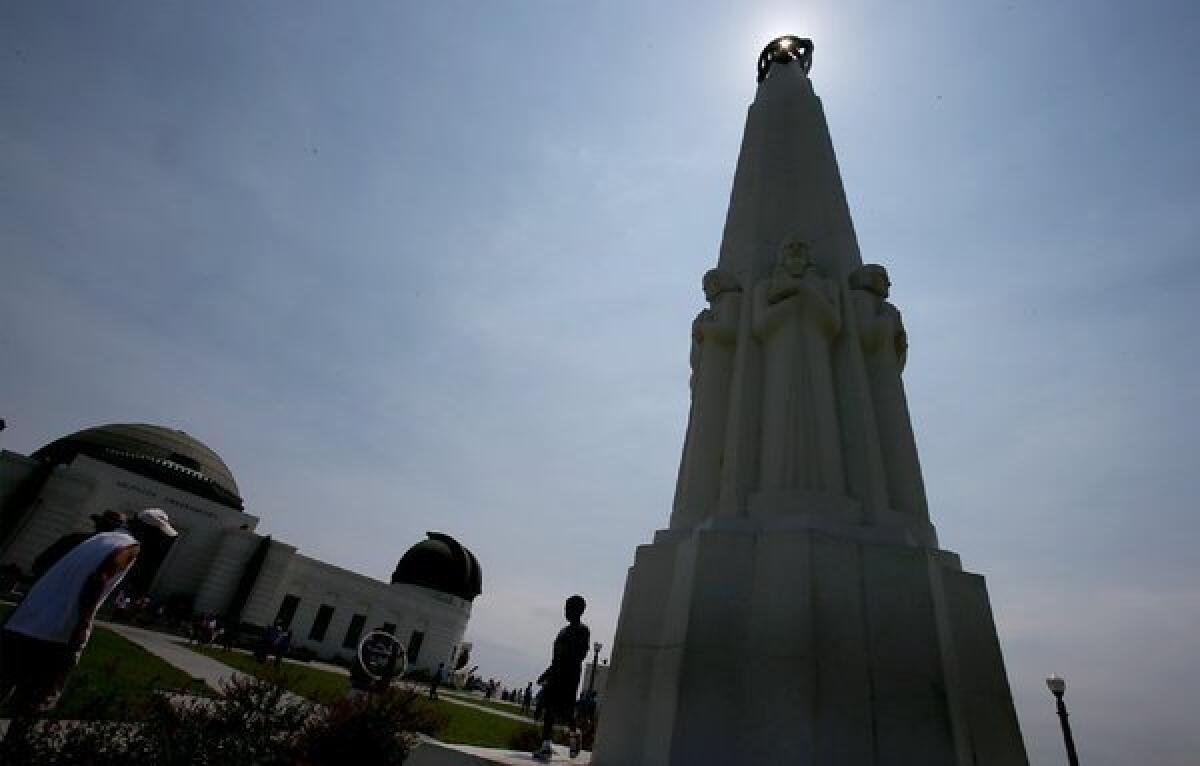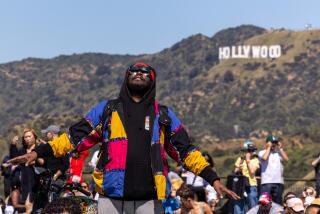Griffith Observatory makes the most of photo shoot from Saturn

- Share via
About 300 visitors gathered on the lawn of Griffith Observatory in Los Angeles Friday afternoon to wave at the Cassini spacecraft as it took their picture from nearly 900 million miles away.
The observatory was already abuzz with visitors when curator Laura Danly picked up a bullhorn and invited everyone to head outside for the cosmic photo shoot. Danly asked who had visited the observatory especially to greet Cassini, and about 100 hands shot into the air.
For the next five minutes, Danly explained the drill -- Cassini would take their picture from the far side of Saturn, pointing out the planet’s location on a diagram of the solar system etched into the concrete near the observatory steps.
The picture would mainly feature the ringed planet, she said, with Earth but a tiny blue speck.
Cassini was taking multiple images and stitching them together to form one large mosaic picture. The image including Earth would take 15 minutes to acquire, but the crowd didn’t have to wave that long if they didn’t want to, Danly explained.
She also asked two observatory staff members to stand about 20 feet apart, where Earth and Saturn were located on a solar system diagram. Playing the role of a light wave, observatory director Edwin Krupp walked from Earth to Saturn, as Danly explained that the light waves carrying Earth’s image would take 80 minutes to reach Cassini’s camera. A few murmurs of “wow” and “whoa” filled the air.
Awesome images of Saturn and its rings
Then Danly pointed out Saturn’s location in the southeastern horizon. Everyone’s heads turned, even though there was no way to see Saturn in the bright daylight.
At precisely 2:20 p.m., Danley gave her command. “Right now!” she shouted, and hands fluttered in the air -- amid a few cheers -- for about two minutes. Then the crowd dispersed.
“It’s a big deal,” said Austin Alley, a tourist from Humboldt who waved to Saturn with his son, high school student and astronomy enthusiast Luke Alley, 16. Like most visitors, the two had only learned about the Saturn wave that day.
“It was a very pleasant surprise,” Austin said.
Asked how she felt about getting her picture taken from hundreds of millions of miles away, 6-year-old Aubrey Johnson of Los Angeles summed up her feelings in one word: “Wow.”
Her older brother, Mason Johnson, 10, widened his eyes, speechless.
Aubrey and Mason waved at Saturn with their mother, Wendy Johnson, from the observatory balcony.
“I think it’s a fun idea,” she said. Getting her picture taken from such a great distance made her “feel very inconsequential,” she said, especially in a society where “we’re so personally focused.”
Saturn — views of rings, moons and more
Scientists will compare Cassini’s new photo with one taken in 2006 to investigate how Saturn’s rings have changed, especially the dusty E ring that measures 620,000 miles wide.
Friday’s photo shoot is unusual because Cassini and the sun are on opposite sides of Saturn. That allowed the planet to be lit from behind, affording scientists a chance to study its rings more closely, Krupp said.
Most photos of Saturn feature sunlight reflecting off the rings. But the brilliant lighting obscures their details. “If nothing else, it’s a beautiful picture worthy of the art galleries of the world,” Krupp said. “It spotlights the human experience and gives us all a chance to be participants in a subconscious way.”
After the photo session, the crowd gradually milled into the observatory for a presentation on Cassini’s discoveries.
Missed the photo op? You can still peer at Saturn through the observatory telescopes from 8:00 p.m. until closing at 10:00 p.m.
Return to Science Now.






